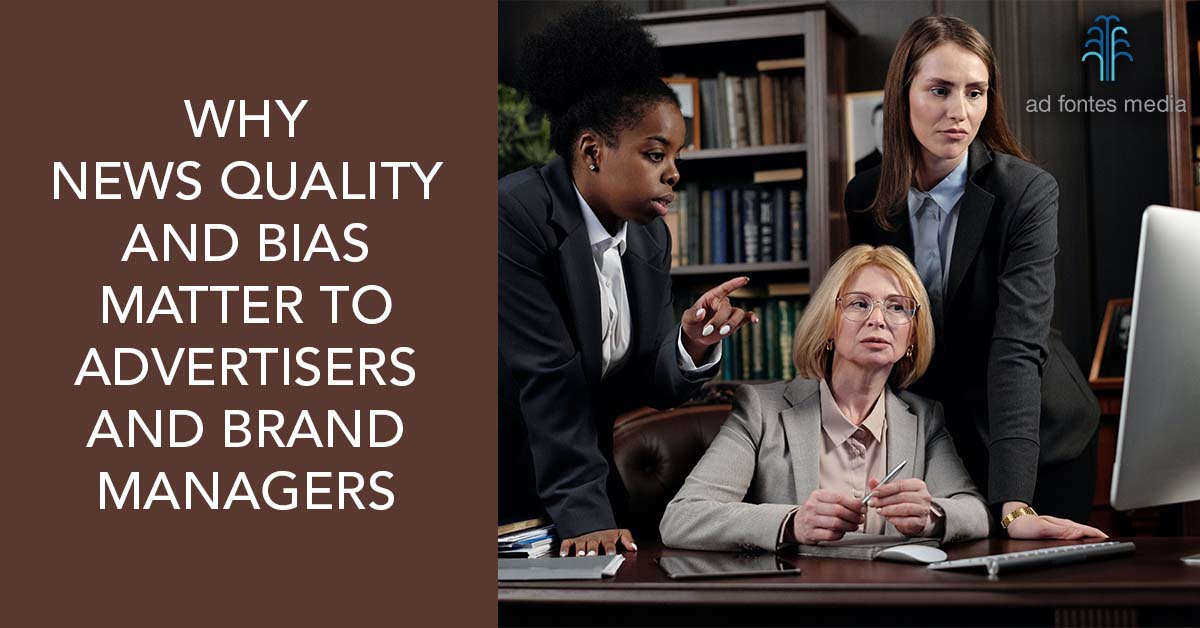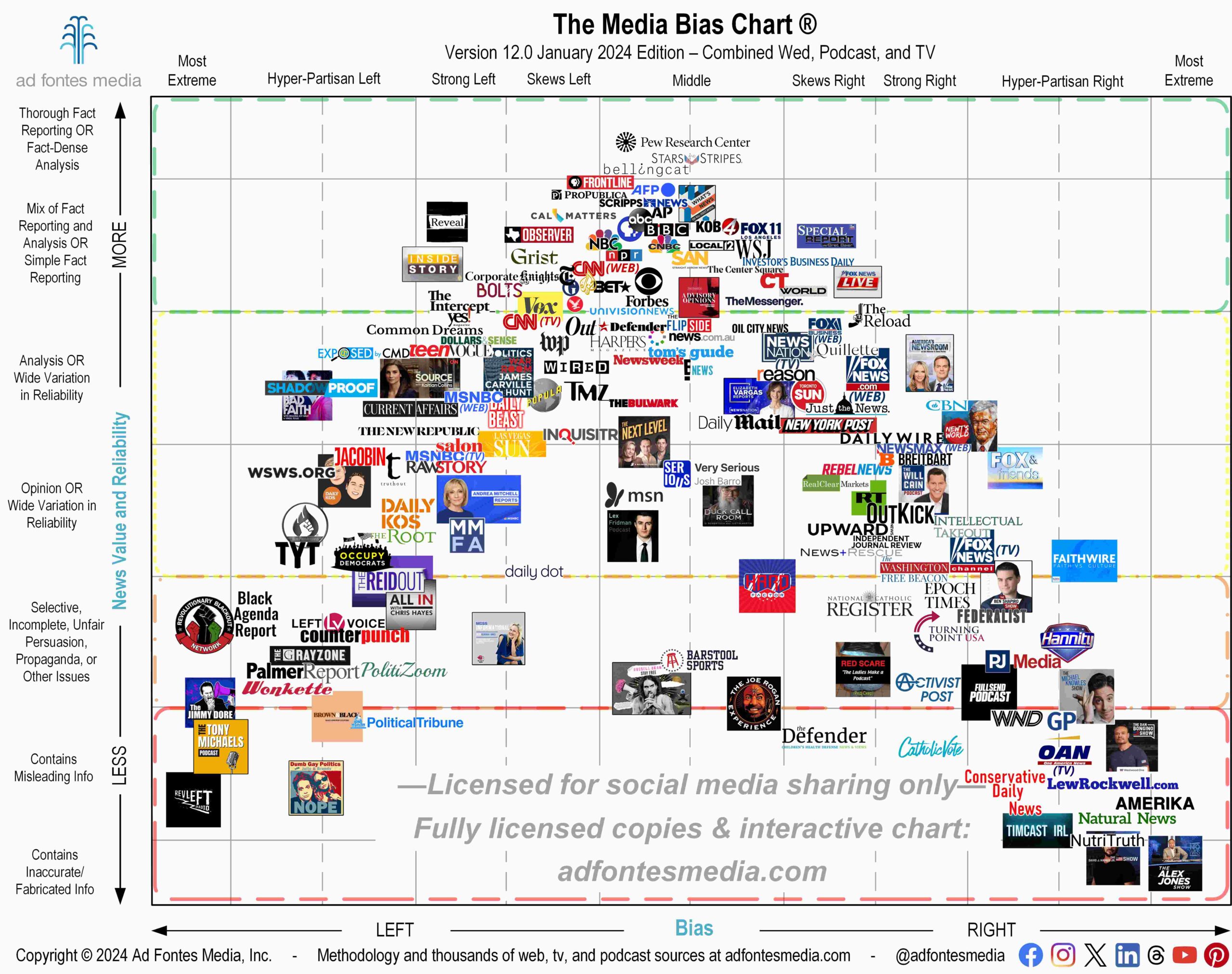Menu

Why News Quality and Bias Matter to Advertisers and Brand Managers
Author:
Vanessa Otero
Date:
05/14/2021
Since I wrote a more detailed version of this blog a year ago, much has changed. However, events like the pandemic, 2020 elections, and storming of the Capitol have only magnified the problem described below. Fortunately, since that time, it also seems that news quality and bias are beginning to matter to an increasing number of advertisers, brand managers, and marketers. As brands seek effective news quality ratings, it’s more important than ever that the tools available be very sharp.
But why is this so important, and how did we get here?
An Explosion of News and “News-Like” Competition
In the past two decades, news content has become digital, and the delivery of this content has become social. With these changes, the number of news sources (and competing “news-like” sources) has exploded and continues to grow. What once required enormous time and money can now be built at a fraction of the time and cost. Nearly anyone can set up a website, create content, and get distribution. It can take as little as a few hundred dollars and just a few days.
These trends have made it easy for new voices to enter the “news” business. However, there is also a danger. Digital advertising models have created warped incentives for junk “news” providers in addition to responsible journalists. They’ve also rewarded peddlers of the most polarizing, sensational, and demonizing opinion content.
All news and news-like content creators compete for attention. The market in which they exist is brutally competitive. Nearly all of them need high traffic and engagement to maximize their revenue potential. Most need it just to survive. However, their challenge is different depending on their place in the market.
For highly reputable long-time news organizations, the explosion of competition has required the reworking of business models. Still, such sources generally remain somewhat constrained by journalistic standards needed to maintain their reputations.
In contrast, many newer online-only sources of news and competing content are less concerned about widespread reputation management. In fact, they often dispense with core journalism ethics and standards. From there, even a small online operation run by a few people can carve out a niche for itself. It can make money solely by generating web traffic and social media engagement. And with money, it can increase its capacity to expand its influence.
One of the easiest ways to generate traffic and engagement is by publishing content that grabs attention. As with all content, news-like content is highly engaging when it stirs powerful emotions. These emotions can include feelings of inspiration, belonging, or just the satisfaction that comes with understanding. However, there is as much power – and maybe more – in emotions like fear, outrage, hatred, bias confirmation, or a sense of superiority.
Increasingly, content producers try to tap into our emotions. Pageviews translate into dollars from digital advertising. But when journalistic standards are dropped, this strategy can succeed much more easily. In other words, polarizing junk news pays.
Brand Managers Emerge
The problem includes publishers of junk news, the audiences that reward them, and sometimes the institutions responsible for educating these consumers. However, a key link between consumers and publishers is advertisers.
As sources for content have multiplied to dizzying numbers, advertising has grown highly targeted. What started with targeting a brand’s most likely demographics became targeting the personal information of each individual user.
When advertising is targeted this deeply, it requires automation in order to be done on a large scale. That means the brand doing the advertising often has little or no knowledge (and often little concern) about the content on which the advertisement is placed. So both good and bad publishers get rewarded for attracting an audience, no matter how they do it. And brands funnel money to both quality journalism outlets and to outlets that spread misinformation and content so biased as to be demonizing.
This contributes to an unhealthy matrix of content-ignorant advertising, lack of consumer education and/or responsibility, and abnormal incentives for content producers. This cycle has clearly been damaging to our society. But advertisers have recently begun to realize it can be damaging to themselves as well.
At first, the concept of “brand safety” was mostly about embarrassing placements: A burger ad next to an E.coli outbreak story; an airline ad next to a plane crash headline. Then it evolved into a broader realization that it’s potentially damaging when brands funnel dollars to creators of content that is dehumanizing, fact-denying, and hate-fomenting. This is because many consumers believe brands choose where they place their ads, even though that is usually not the case. What’s more, consumers often continue to hold brands responsible for ad placement even when they understand user-targeted advertising.
This is generally not a problem for brand managers whose ads end up near moderately biased or moderately opinionated analysis. However, it can be very harmful if their ads end up funding publishers of hate-filled rhetoric or untruth that leads to violence and chaos. Even brands with mission statements about how they value diversity, equality, civility, sustainability, and corporate citizenship can have it happen to them. This is because even brands that care about the fact that their ads appear next to horrible “news-like” content have a problem. The problem is that it has been hard to find tools to avoid junk “news” without avoiding good journalism as well.
Unintended Consequences
The Drum, an ad industry publication, states that advertisers are in a “race to brand safety” and that “the current reliance upon keywords is disproportionately (and ironically) penalizing, sites with a greater journalistic impact who run high quality, editorially-governed environments.” The Wall Street Journal notes, “some companies are creating keyword blacklists so detailed as to make almost all political or hard-news stories off-limits for their ads.”
Brand managers’ use of tools this blunt has been disastrous for many quality news outlets. Recent events have turned this into a crisis. Keyword blocking of important stories has been starving good national publishers of vital revenue at the very moment they are doing the most crucial work. And the suffering has been felt most by local news outlets, to the detriment of communities.
High-quality news publishers have increasingly turned to readers to solve revenue problems through paywalls, and they continue to do so. At the same time, the overwhelming majority of the lowest-quality sources in the news landscape rely on neither subscriptions nor donations. They are almost all driven by user-targeted advertising revenue, meaning they are rising to the top in terms of accessibility.
In short, the inability of advertising technology to distinguish between good journalism and junk news has been contributing to a vicious cycle. This cycle continues to worsen our entire news ecosystem, even when brands are concerned about the problem.
It Takes All of Us
What can we do? We must avoid simplistic solutions that point exclusively to one of many players in the dynamics that shape our news ecosystem. Consumers must keep themselves news literate. Educators need to teach students to stay media literate. And we all need to hold content publishers and brands accountable.
But if publishers and brand managers lack the tools to fulfill their share of responsibility, efforts at pressure from consumers can have unintended consequences. They can end up punishing the best publishers rather than the worst.
The Final Word; Why We are Here
These kinds of complex problems are why we created Ad Fontes Media. We believe all stakeholders in good journalism need good tools. As the dynamics of the news landscape shift, we continue to build tools to measure, identify, and avoid bias for consumers, educators, and publishers; and we build smarter platforms for advertisers and brand managers.
Interested in seeing our latest programs? Stop by our home to check out our products to upgrade your lenses for reading accuracy and bias in the news. Repairing our news ecosystem takes all of us, brands included. Let’s be part of the solution.
Vanessa Otero
Vanessa is a former patent attorney in the Denver, Colorado area with a B.A. in English from UCLA and a J.D. from the University of Denver. She is the original creator of the Media Bias Chart (October 2016), and founded Ad Fontes Media in February of 2018 to fulfill the need revealed by the popularity of the chart — the need for a map to help people navigate the complex media landscape, and for comprehensive content analysis of media sources themselves. Vanessa regularly speaks on the topic of media bias and polarization to a variety of audiences.



